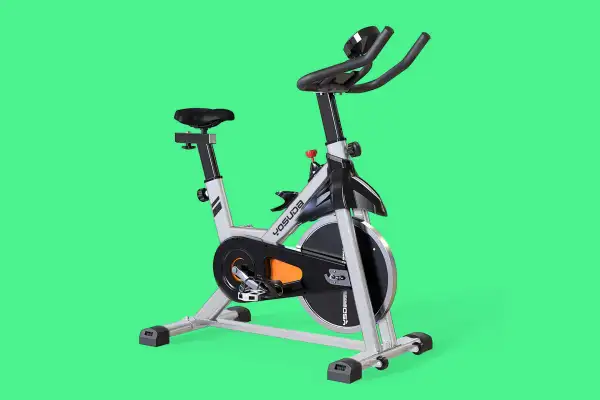The Best Exercise Bikes for Your Money

Riding a stationary bike is one of the best forms of aerobic exercise. Not only is it an effective way to burn calories, it can help improve your cardiovascular health and strengthen your lower body muscles. Cycling is also considered a low-impact exercise so it won't place excessive strain on your hips, knees, or ankles.
Exercise bikes cost anywhere from $200 for the traditional stationary ones, all the way up to more than $2,000 for the so-called connected bikes, which let you join live and on-demand classes through their built-in screens. Recently, Peloton, the cult brand often deemed responsible for fueling the high-energy connected-bike craze, reported a 232% increase in sales and is estimated to have over 1 million subscribers — each one willing to spend over $2,000 on a bike, plus $39 per month in dues.
All exercise bikes, no matter the price, and no matter if they're connected or not, share one important feature in common: a resistance system. A bike’s resistance system dictates how challenging (or not) your workout can be.
Most bikes come with a monitor that tracks and displays at least some basic stats such as calories burned, distance, and speed. Higher-priced models can measure additional data like heart rate and cadence (the rate at which you pedal) and provide personalized performance reports. Other extras like a bottle holder, a device tray, a fan, or a touchscreen are a matter of preference. They won’t really enhance your workout, but they may make it more pleasant — and that could mean you’ll be more likely to hop on the bike in the first place.
Exercise bike buying guide
When it comes to picking your ideal exercise bike, it all comes down to how much you’re going to use it and what you hope to achieve. Here are a few factors to keep in mind as you browse for a bike that best fits your needs.
• Bike type. There are two main types of exercise bikes: upright and recumbent bikes. With an upright bike you’ll be riding in a similar position to a road bike. These bikes can keep your core engaged and provide more of a full-body workout, but riding for long periods of time can leave you with a sore back (and sore backside), especially when you're a beginner or recovering from injuries. Recumbent bikes, on the other hand, are more suitable for people with knee or back problems as they are designed so the rider is seated in a reclined position. These bikes are usually around 10” longer than upright bikes since their seats are further back from the handles. It’s also possible they are several inches wider depending on the size of the seat (which is similar to a chair).
• Connected bikes. Connected bikes are a trendier category of upright bikes that make indoor cycling a more immersive experience, by offering live and on-demand cycling classes that can be viewed directly on the bike’s built-in screen. Their platforms usually include other fitness and wellness classes like strength training, HIIT, yoga, and meditation. However, the bikes themselves can cost thousands of dollars and, if you want to reap the full benefits, you’ll have to pay for a monthly subscription that may add $15 and $40 more per month. These extra expenses may be worth it if your fitness routine is centered around your bike, or if you find the community interaction (and competition) motivating.
• Resistance. Most exercise bikes have a magnetic resistance system. Basically, magnets are placed around a bike’s flywheel, and they create different levels of resistance as they get closer or further away from the flywheel. Resistance levels can range between eight to up to a 100. How many levels of resistance you need depends on your fitness routine and goals. An eight-level system provides sufficient resistance to push yourself during basic cycling workouts, but some riders (especially serious cyclists) often prefer more for added difficulty and control. A bike with more resistance levels also allows for finer adjustments to achieve a more fluid feel in the ride.
• Pedal design. Most affordable exercise bikes feature flat pedals with adjustable toe cages or straps that work with any conventional sneaker. But some bikes, especially higher-priced ones, require that you use specialized clip-in cycling shoes. In that case, consider the cycling shoes an added expense — unless, of course, you already own clip-in shoes and use them with a road bike.
Best exercise bikes
1. Best for immersive experience: NordicTrack Commercial S22i Studio Cycle
Weight limit: 350 lbs | Resistance: 24 digital resistance levels | Monitor: 360° Rotating HD Touchscreen Bike Size: 55.0" L x 21.9" W x 56.9" H
The NordicTrack Commercial S22i takes stationary cycling to a whole new level by simulating hills with its incline/decline mechanism, a feature even the renowned Peloton lacks. The levels will automatically adjust as you watch workouts through the built-in iFit platform — the same goes for speed and resistance. Trainers can also make remote adjustments as you follow live classes. (You can, however, make manual adjustments at any time if you’d rather take it easier.)
The incline-decline mechanism becomes even more impressive when paired with iFit’s across-the-world workout library. Pick a location and the bike's 22” monitor transports you to scenic routes across the Swiss Alps, Indonesia, the Tour de France, and more. Your bike will adjust to reflect the steepness of the road, trail, or hill you’re virtually riding. You can also set routes anywhere in the world using Google Maps data. The images shown in the monitor won’t be nearly as clear as the ones from the professionally-recorded scenic routes, but it's another option to change up your routine.
Keep in mind that all of these features are only available through an iFit membership, which costs $396 per year or $39 per month for a family plan, or $180 per year for the individual plan. You can still use the bike in manual mode without a subscription, but you won’t get the immersive experience that really sets it apart.
If the S22i ($1,999 plus delivery fee) is out of your budget, consider the NordicTrack Commercial S15i Studio Cycle" ($1,699), which has the same features with a 15” screen instead.
2. Editor's pick: YOSUDA Indoor Cycling Bike
Weight limit: 270 lbs | Resistance: Infinite resistance adjustment system | Monitor: LCD | Bike Size: 40"L x 22" W x 45" H
Retailing for around $350, the YOSUDA Indoor Cycling Bike offers pretty much everything you need for a spin workout at home for a reasonable price.
Instead of having pre-customized workouts, it provides a knob that lets you gradually increase the resistance level, letting you tailor your session to exactly what you need that day.
While the YOSUDA’s LCD monitor only displays basic metrics such as time, speed, distance, and calories burned, it has a small shelf where you can place a smartphone or tablet and stream your favorite shows or classes while you spin. Users also praise its sturdy construction and cage pedals, which help support the feet and prevent slips.
It’s worth noting that the YOSUDA requires the rider to be upright (like a road bike). While this will engage core muscles and offer a great workout, it might not be appropriate for those with back injuries.
3. Best for low prices and comfort: Marcy ME-709 Recumbent Exercise Bike
Weight limit: 300 lbs | Resistance: 8-level magnetic resistance | Monitor: LCD | Bike Size: 55.5"L x 25"W x 37.5"H
If you’re just starting to ride, are recovering from injuries, or simply need more back support, a recumbent bike probably makes more sense for you. While working out with a recumbent bike might seem like less of a challenge, you can definitely break a sweat with the appropriate resistance setting.
The Marcy ME-709 offers eight levels of resistance so you can push yourself as needed. Its padded, comfortable seat features a handlebar, which can help you keep proper back alignment throughout your workout. The weighted pedals also provide increased stability, with texture and straps to prevent your feet from slipping.
Overall, this bike has the basic features needed to achieve a light- to moderate-intensity workout without placing excessive strain on your joints or back. It's very affordable too, typically on sale for $200 or less.
4. Best for small spaces: Exerpeutic Folding Magnetic Upright Exercise Bike
Weight limit: 300 lbs | Resistance: 8-level magnetic resistance | Monitor: LCD | Bike Size: 31”L x 19”W x 46”H Assembled, 22” L x 20” W x 55.5” H Folded
The Exerpeutic Folding Magnetic Upright Bike is a great option if you don't have much room for a standard-sized exercise bike. When folded, the bike is around 10” smaller than its original length — and even when fully assembled it’s smaller than most non-foldable bikes. The compact size doesn’t weaken its frame though. The Exerpeutic can hold up to 300 pounds and is appropriate for people up to 6’1” tall.
Exerpeutic provides an 8-level magnetic resistance system, enough to provide a light-to-moderate cardio workout. Additionally, its wide seat (14.6”) can provide a pretty comfortable ride.
In terms of features, the Exerpeutic gives you the basics, and not much more. However, thanks to built-in pulse sensors in the handlebars, its LCD monitor tracks your heart rate, and it does offer a cell phone sleeve to keep your phone within your (and your headphones’) reach.
5. Peloton Bike
Weight limit: 297 lbs | Resistance: 100-level magnetic resistance | Monitor: 22″ HD Touchscreen | Bike Size: 59" L x 53" H x 23" W
Peloton is undoubtedly one of the top names when it comes to at-home fitness equipment, and for good reason. The Peloton bike started the connected-indoor-cycling craze and continues to be popular for its thousands of on-demand classes, and up to 14 daily live sessions led by professional instructors. The Peloton platform also offers off-the-bike programs that include yoga, strength training, cardio high-intensity interval training, bootcamp, and meditation. With both Bluetooth and WiFi support, you can sync and track your progress with your smartwatch or phone.
As connected bikes with varied repertoires of classes continue to pop up, perhaps what keeps Peloton as a top player is its community. The bike allows you to interact with other Peloton riders using customizable profile tags to identify riders with similar backgrounds or hobbies to yours. You can give other riders "high fives" (Peloton’s version of a Facebook poke), follow people and see their workout history, and video chat with friends as you work out together. There’s also a leaderboard feature where all riders, including yourself, are ranked based on performance. This can be a great feature for spinning enthusiasts who thrive on competition.
The Peloton bike used to cost $2,245, but the company recently unveiled a newer model (Peloton Bike+) and lowered the basic model down to $1,295. Peloton’s fitness platform costs $39 per month ($468 per year). You’ll also need special clip-in shoes which you can either buy from Peloton or a bike shop.
More From Money:
The Best Treadmills for Your Money, Recommended by Fitness Pros
How to Buy a Bike in the Middle of the Largest Shortage in U.S. History
The Best Smartwatches for Your Money, According to Tech and Fitness Experts
